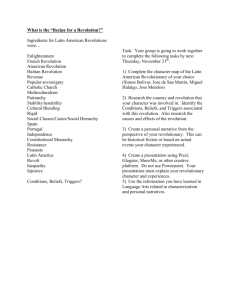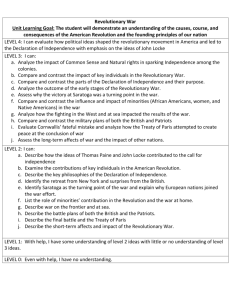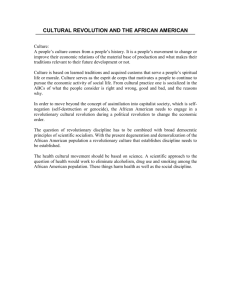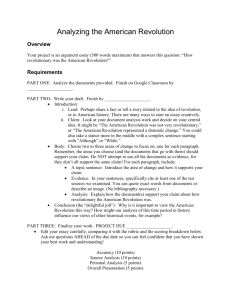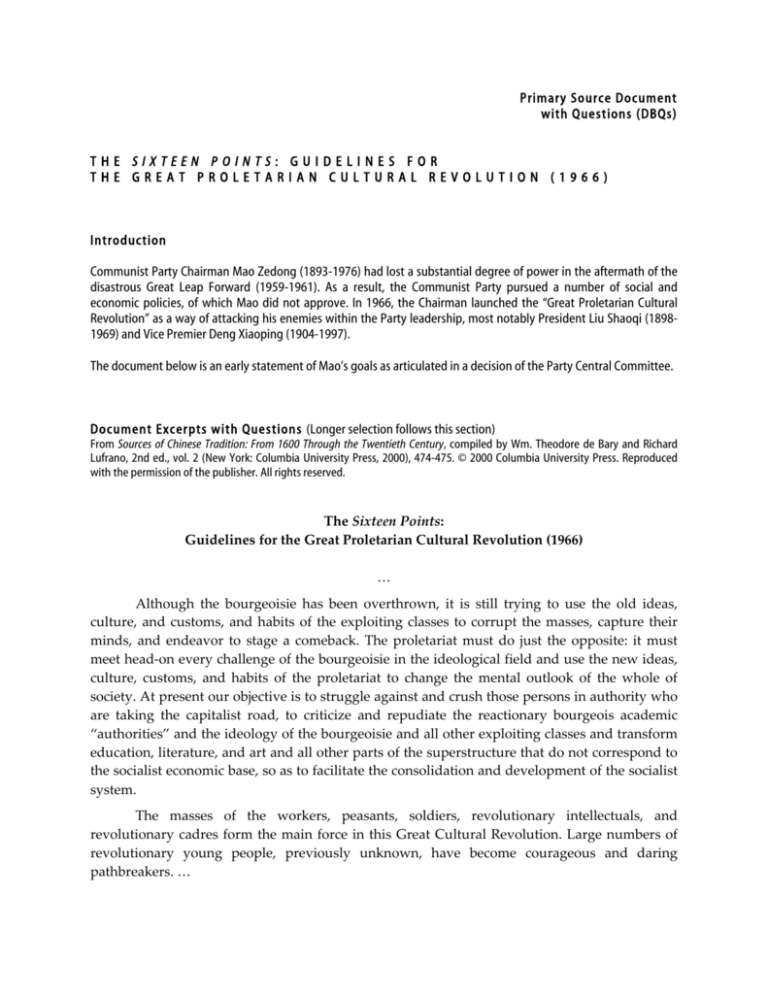
Primary Source Document
with Questions (DBQs)
THE SIXTEEN POINTS: GUIDELINES FOR
THE GREAT PROLETARIAN CULTURAL REVOLUTION (1966)
Introduction
Communist Party Chairman Mao Zedong (1893-1976) had lost a substantial degree of power in the aftermath of the
disastrous Great Leap Forward (1959-1961). As a result, the Communist Party pursued a number of social and
economic policies, of which Mao did not approve. In 1966, the Chairman launched the “Great Proletarian Cultural
Revolution” as a way of attacking his enemies within the Party leadership, most notably President Liu Shaoqi (18981969) and Vice Premier Deng Xiaoping (1904-1997).
The document below is an early statement of Mao’s goals as articulated in a decision of the Party Central Committee.
Document Excerpts with Questions (Longer selection follows this section)
From Sources of Chinese Tradition: From 1600 Through the Twentieth Century, compiled by Wm. Theodore de Bary and Richard
Lufrano, 2nd ed., vol. 2 (New York: Columbia University Press, 2000), 474-475. © 2000 Columbia University Press. Reproduced
with the permission of the publisher. All rights reserved.
The
Sixteen
Points:
Guidelines
for
the
Great
Proletarian
Cultural
Revolution
(1966)
…
Although
the
bourgeoisie
has
been
overthrown,
it
is
still
trying
to
use
the
old
ideas,
culture,
and
customs,
and
habits
of
the
exploiting
classes
to
corrupt
the
masses,
capture
their
minds,
and
endeavor
to
stage
a
comeback.
The
proletariat
must
do
just
the
opposite:
it
must
meet
head‑on
every
challenge
of
the
bourgeoisie
in
the
ideological
field
and
use
the
new
ideas,
culture,
customs,
and
habits
of
the
proletariat
to
change
the
mental
outlook
of
the
whole
of
society.
At
present
our
objective
is
to
struggle
against
and
crush
those
persons
in
authority
who
are
taking
the
capitalist
road,
to
criticize
and
repudiate
the
reactionary
bourgeois
academic
“authorities”
and
the
ideology
of
the
bourgeoisie
and
all
other
exploiting
classes
and
transform
education,
literature,
and
art
and
all
other
parts
of
the
superstructure
that
do
not
correspond
to
the
socialist
economic
base,
so
as
to
facilitate
the
consolidation
and
development
of
the
socialist
system.
The
masses
of
the
workers,
peasants,
soldiers,
revolutionary
intellectuals,
and
revolutionary
cadres
form
the
main
force
in
this
Great
Cultural
Revolution.
Large
numbers
of
revolutionary
young
people,
previously
unknown,
have
become
courageous
and
daring
pathbreakers.
…
Primary Source Document, with Questions (DBQ) on
THE SIXTEEN POINTS: GUIDELINES FOR THE GREAT PROLETARIAN CULTURAL REVOLUTION (1966)
Questions:
1. Mao Zedong and the Communist Party’s Central Committee do not state the
names of those “persons in authority who are taking the capitalist road.” If
you were a Chinese person reading this in 1966, and if you yourself were not
clear on exactly which individuals were the targets, what would you do?
2. What steps would you take to carry out this Central Committee policy in
your own local community or your own high school, college, or university?
3. If you identified yourself as a “revolutionary intellectual,” whom would you
attack and overthrow?
Longer Selection
From Sources of Chinese Tradition: From 1600 Through the Twentieth Century, compiled by Wm. Theodore de Bary and Richard
Lufrano, 2nd ed., vol. 2 (New York: Columbia University Press, 2000), 474-475. © 2000 Columbia University Press. Reproduced
with the permission of the publisher. All rights reserved.
The
Sixteen
Points:
Guidelines
for
the
Great
Proletarian
Cultural
Revolution
(1966)
1.
A
New
Stage
in
the
Socialist
Revolution
The
Great
Proletarian
Cultural
Revolution
now
unfolding
is
a
great
revolution
that
touches
people
to
their
very
soul
and
constitutes
a
new
stage
in
the
development
of
the
socialist
revolution
in
our
country,
a
deeper
and
more
extensive
stage.
…
Although
the
bourgeoisie
has
been
overthrown,
it
is
still
trying
to
use
the
old
ideas,
culture
and
customs,
and
habits
of
the
exploiting
classes
to
corrupt
the
masses,
capture
their
minds,
and
endeavor
to
stage
a
comeback.
The
proletariat
must
do
just
the
opposite:
it
must
meet
head‑on
every
challenge
of
the
bourgeoisie
in
the
ideological
field
and
use
the
new
ideas,
culture,
customs,
and
habits
of
the
proletariat
to
change
the
mental
outlook
of
the
whole
of
society.
At
present
our
objective
is
to
struggle
against
and
crush
those
persons
in
authority
who
are
taking
the
capitalist
road,
to
criticize
and
repudiate
the
reactionary
bourgeois
academic
“authorities”
and
the
ideology
of
the
bourgeoisie
and
all
other
exploiting
classes,
and
transform
education,
literature,
and
art
and
all
other
parts
of
the
superstructure
that
do
not
correspond
to
the
socialist
economic
base,
so
as
to
facilitate
the
consolidation
and
development
of
the
socialist
system.
2.
The
Main
Current
and
the
Zigzags
The
masses
of
the
workers,
peasants,
soldiers,
revolutionary
intellectuals,
and
revolutionary
cadres
form
the
main
force
in
this
Great
Cultural
Revolution.
Large
numbers
of
revolutionary
young
people,
previously
unknown,
have
become
courageous
and
daring
pathbreakers.
They
are
vigorous
in
action
and
intelligent.
Through
the
media
of
big
character
Asia for Educators | Columbia Univers ity | http://afe.easia.columbia.edu
Page 2 of 3
Primary Source Document, with Questions (DBQ) on
THE SIXTEEN POINTS: GUIDELINES FOR THE GREAT PROLETARIAN CULTURAL REVOLUTION (1966)
posters
and
great
debates,
they
argue
things
out,
expose
and
criticize
thoroughly,
and
launch
resolute
attacks
on
the
open
and
hidden
representatives
of
the
bourgeoisie.
…
Since
the
Cultural
Revolution
is
a
revolution,
it
inevitably
meets
with
resistance.
This
resistance
comes
chiefly
from
those
in
authority
who
have
wormed
their
way
into
the
party
and
are
taking
the
capitalist
road.
It
also
comes
from
the
old
force
of
habit
in
society.
At
present,
this
resistance
is
still
fairly
strong
and
stubborn.
However,
the
Great
Proletarian
Cultural
Revolution
is,
after
all,
an
irresistible
general
trend.
There
is
abundant
evidence
that
such
resistance
will
crumble
fast
once
the
masses
become
fully
aroused.
…
9.
Cultural
Revolutionary
Groups,
Committees,
and
Congresses
Many
new
things
have
begun
to
emerge
in
the
Great
Proletarian
Cultural
Revolution.
The
cultural
revolutionary
groups,
committees,
and
other
organizational
forms
created
by
the
masses
in
many
schools
and
units
are
something
new
and
of
great
historic
importance.
These
cultural
revolutionary
groups,
committees,
and
congresses
are
excellent
new
forms
of
organization
whereby
under
the
leadership
of
the
Communist
Party
the
masses
are
educating
themselves.
They
are
an
excellent
bridge
to
keep
our
party
in
close
contact
with
the
masses.
They
are
organs
of
power
of
the
Proletarian
Cultural
Revolution.
The
cultural
revolutionary
groups,
committees,
and
congresses
should
not
be
temporary
organizations
but
permanent,
standing
mass
organizations.
They
are
suitable
not
only
for
colleges,
schools,
government,
and
other
organizations
but
generally
also
for
factories,
mines,
and
other
enterprises,
urban
districts,
and
villages.
It
is
necessary
to
institute
a
system
of
general
elections,
like
that
of
the
Paris
Commune,
for
electing
members
to
the
cultural
revolutionary
groups
and
committees
and
delegates
to
the
cultural
revolutionary
congress.
Asia for Educators | Columbia Univers ity | http://afe.easia.columbia.edu
Page 3 of 3





